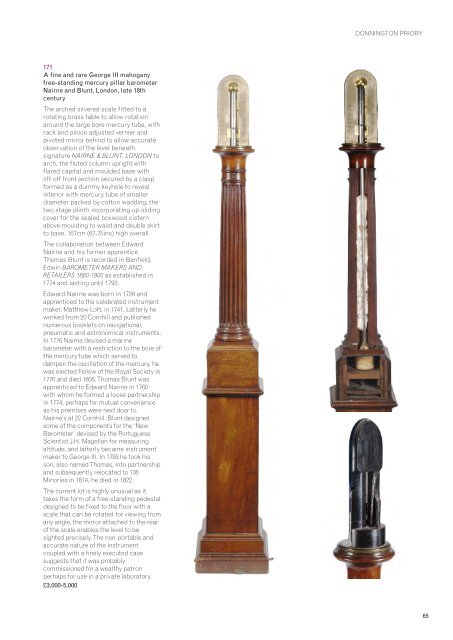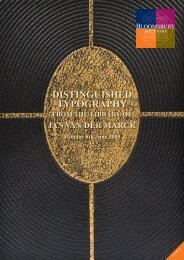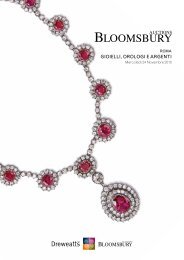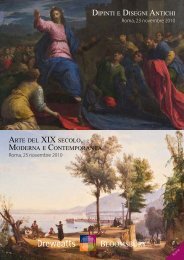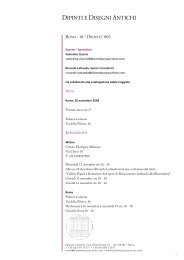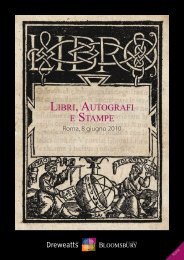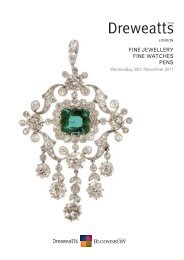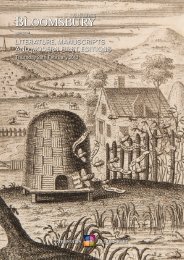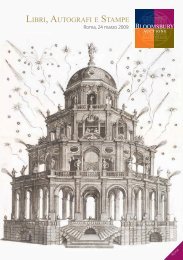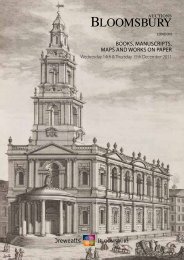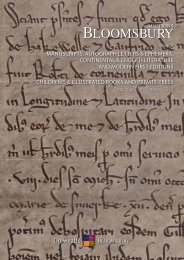PDF Download - Bloomsbury Auctions
PDF Download - Bloomsbury Auctions
PDF Download - Bloomsbury Auctions
You also want an ePaper? Increase the reach of your titles
YUMPU automatically turns print PDFs into web optimized ePapers that Google loves.
171<br />
A fine and rare George III mahogany<br />
free-standing mercury pillar barometer<br />
Nairne and Blunt, London, late 18th<br />
century<br />
The arched silvered scale fitted to a<br />
rotating brass table to allow rotation<br />
around the large bore mercury tube, with<br />
rack and pinion adjusted vernier and<br />
pivoted mirror behind to allow accurate<br />
observation of the level beneath<br />
signature NAIRNE & BLUNT, LONDON to<br />
arch, the fluted column upright with<br />
flared capital and moulded base with<br />
lift-off front section secured by a clasp<br />
formed as a dummy keyhole to reveal<br />
interior with mercury tube of smaller<br />
diameter packed by cotton wadding, the<br />
two stage plinth incorporating up-sliding<br />
cover for the sealed boxwood cistern<br />
above moulding to waist and double skirt<br />
to base, 167cm (67.75ins) high overall.<br />
The collaboration between Edward<br />
Nairne and his former apprentice<br />
Thomas Blunt is recorded in Banfield,<br />
Edwin BAROMETER MAKERS AND<br />
RETAILERS 1660-1900 as established in<br />
1774 and lasting until 1793.<br />
Edward Nairne was born in 1726 and<br />
apprenticed to the celebrated instrument<br />
maker, Matthew Loft, in 1741. Latterly he<br />
worked from 20 Cornhill and published<br />
numerous booklets on navigational,<br />
pneumatic and astronomical instruments.<br />
In 1776 Nairne devised a marine<br />
barometer with a restriction to the bore of<br />
the mercury tube which served to<br />
dampen the oscillation of the mercury, he<br />
was elected Fellow of the Royal Society in<br />
1776 and died 1806. Thomas Blunt was<br />
apprenticed to Edward Nairne in 1760<br />
with whom he formed a loose partnership<br />
in 1774, perhaps for mutual convenience<br />
as his premises were next door to<br />
Nairne’s at 22 Cornhill. Blunt designed<br />
some of the components for the ‘New<br />
Barometer’ devised by the Portuguese<br />
Scientist J.H. Magellan for measuring<br />
altitude, and latterly became instrument<br />
maker to George III. In 1793 he took his<br />
son, also named Thomas, into partnership<br />
and subsequently relocated to 136<br />
Minories in 1814, he died in 1822.<br />
The current lot is highly unusual as it<br />
takes the form of a free-standing pedestal<br />
designed to be fixed to the floor with a<br />
scale that can be rotated for viewing from<br />
any angle, the mirror attached to the rear<br />
of the scale enables the level to be<br />
sighted precisely. The non-portable and<br />
accurate nature of the instrument<br />
coupled with a finely executed case<br />
suggests that it was probably<br />
commissioned for a wealthy patron<br />
perhaps for use in a private laboratory.<br />
£3,000-5,000<br />
DONNINGTON PRIORY<br />
65


